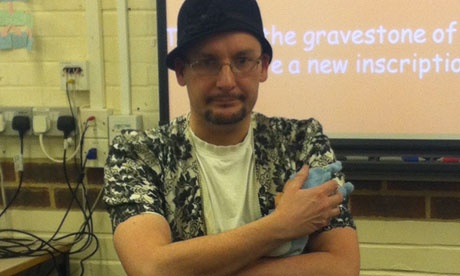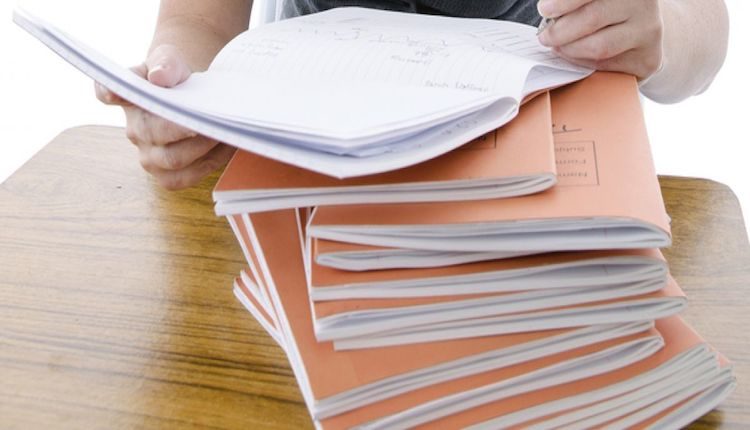It’s period 4 on a Thursday and Year 11 are filing through my classroom door with a collective look of bemusement on their faces. Some are just outright laughing at me; others are reaching for their camera phones. I’d like to point out that these are not the normal responses I get from my students.
What is different today is that I am sitting on an old car tyre at the front of the classroom next to a battered suitcase, holding a toy baby, wearing a very nice 1920s dress and hat combo.
Projected onto the interactive whiteboard behind me are the words “Any questions?” As a means of creating interest it works a treat. As a means of settling a class, not so much.
The reason for subjecting students to the sight of my legs was that the lesson was designed around the story of the famous Migrant Mother photograph.
Half way through the lesson, having investigated the standard story of Dorothea Lange’s photograph, we would turn the tale on its head by interviewing the subject of the photograph, Florence Thompson.
The use of the personal story is, I believe, an incredibly effective mechanism through which we can create engagement, bring the past to life and, in the context of Depression era America, enliven a potentially very dry subject.
I am a firm advocate of using the personal story as an historical tool. To quote historical educator Ian Luff, ‘(the personal story) has great power in combating the all-too-common tendency for kids to see any period of the past as part of an amorphous fog of ‘The Olden Days’ and therefore impossibly distant from their own lives’.
I am also an advocate of using drama and role play in the classroom. The problem I have with the latter is that I have always utterly sucked at it. In my early years as a teacher I often succumbed to the entreaties of my students to “do some drama”.
I tried, I failed. Every time, these well intentioned efforts devolved into Year 8 boys running around hitting each other. As an antidote to this, I began to experiment with two drama-based approaches: Teacher in Role and Scripted Role Play. The subject of this blog post will be the concept of Teacher in Role.
I came across the concept of Teacher in Role by way of Paul Ginnis’ excellent book, The Teacher’s Toolkit. Paul Ginnis passed away recently and will be sorely missed by all he influenced. The idea is simple: research an historical personage, ask students to write interview questions, choose a prop (when you are holding it you are the historical figure, when you put it down, you may be addressed as the class teacher) and get going. Over the last few years I have, in addition to Florence Thompson, been; Cecil Rhodes, Captain Collingwood of the slave ship Zong, my own great grandfather at the battle of the Somme, George Meredith (recipient of 1900’s social reforms) and a participant in the Jarrow March.
You could easily adapt some of our lessons to put teacher in role. You could get your students to interview Captain Gwyn, asking him why he smuggled goods in the 1700s. You could be Lenny from our 1930s lesson and ask about his holidays / life, you could ask the people of St Winifred’s church, why they vandalised the rood screen but didn’t completely remove it… the choices are endless.
I have also taken the advice of the British Museum that “objects are absent people” and role played a 19th Century cavalry sabre, an English Civil War helmet and a miner’s safety lamp. Here is more on the use of artefacts.
So, why bother? Firstly, it’s fun. Students learn best when lessons are engaging and memorable. Secondly, it is a very effective way of transmitting information to students in a way that avoids simple note taking. Thirdly, it is an effective tool for developing oracy in the classroom. I like my students to talk and this whole activity is based upon talk.
Should you decide to act in role, a couple of pointers might help. Firstly, do your research. Get to know your historical figure and make notes. I often write key points, dates, etc. on post-it notes and place them around the room. I can then pace the room and check my facts as the interview progresses. Secondly, as I mentioned earlier, get a prop. This can serve to distinguish between when you are speaking as the person and when you are back to being teacher. Borrowing from Ian Dawson, (www.thinkinghistory.co.uk), a simple tabard made from sugar paper with the name of the character written on it will often suffice. Thirdly, consider how you can create some atmosphere.
For a Medieval peasant, conduct the interview by candle light (be careful). For a monk, consider using plainsong. Finally, do not underestimate the importance of a good de-brief. Talk to your class, find out what they have learned and encourage them to consider what else they need to know. This last point is key to students developing an understanding that history is a construct based upon the available evidence. Our view of the past can always be improved, added to and challenged by new evidence.
I wish readers every success in their role playing endeavours.
Memorable history lessons: dress up, role play and personal stories by Neil Bates
This article was first written for The Guardian in 2013





